It’s getting to that time of year again. It’s hot here in Atlanta, and really hot down in Mexico, where, in between the tropical storms and occasional hurricanes, dog days are settling over the Yucatan Peninsula. It’s also the time when whale sharks begin to gather in big numbers off the coast, not far from Cancun. So it’s time to trade hot for hotter and humid for more humider…er and get out there for some field work! (magic words, “field work”, aren’t they?).
The Georgia Aquarium whale shark research group that I coordinate will have several research aims this year (some of which I will write more on in future posts), but for this first trip we will be putting significant effort towards photo identification work, which is done using a technique just too cool not to share!
Photo ID is not new of course. Marine biologists have long used photography as a tool to assist in identifying and counting animals. Dolphin researchers use the patterns of scars on dorsal fins, whale researchers study unique fluke patterns and barnacle distributions, and manta ray researchers use blotch patterns on the belly, all to discriminate individuals in a population. This information can then be used to estimate population size and to track individual animals as they move around or migrate, in a completely non-invasive fashion.
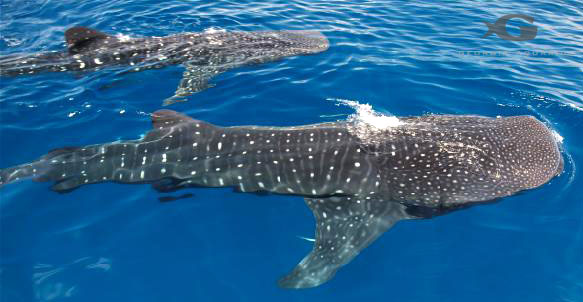
The obvious approach with whale sharks is to use their inherent spottiness to scientific advantage, but how? They’re just so…spotty. Enter clever folks Zaven Azroumanian, Jason Holmberg and Dr. Brad Norman. These three adapted some computer algorithms used to identify patterns of stars in the sky, in order to identify individual whale sharks based on the unique pattern of spots on their flanks. How cool is that? Then they formed ECOCEAN, a global whale shark photo ID database and citizen science project. It works like this:
1. You photograph the left flank of a whale shark, in the area above the pectoral fin, level and perpendicular with the animal, thus:
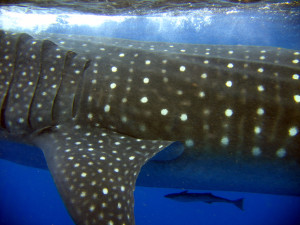
2. You upload the image, along with pertinent details, via the ECOCEAN website. An ECOCEAN-affiliated scientist like me processes the image, cropping, straightening and marking the spots and some other important anatomical landmarks
3. The software compares the photo to a database of over 3,000 different animals using a couple of different similarity algorithms, and then returns a list of possible matches with scores for how good a match each is. It looks like this:
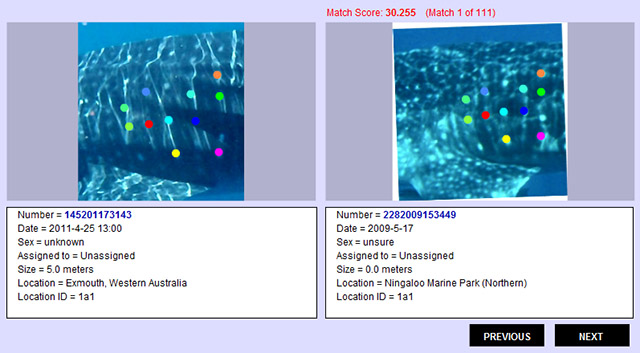
4. An ECOCEAN-affiliated scientist like me then makes the final call on whether the photo matches an existing animal (i.e. is a re-sighting), or whether it’s a first timer, in which case it gets assigned a unique ID number that will follow it throughout its days.
5. The submitter gets an email telling them whether their animal is already known to ECOCEAN, or is new.
6. (and this is especially cool) Thereafter, whenever that animal is seen again, any submitter of a picture of that animal also gets an email letting them know that “their” animal has been resighted.
It’s a terrific idea. So far thousands of animals have been added from exotic places like Ningaloo (Australia), Donsol (Philippines), Thailand, Maldives, Mozambique, Djibouti and Belize. In recent times, few of these places have had as many opportunities to contribute to the database as Mexico, both Baja California and especially the group we study in the Yucatan. That’s because of the extraordinary annual gathering we call the Afuera, which is the biggest whale shark aggregation in the world, and the research carried out by the partners in Project Domino including Georgia Aquarium, the Smithsonian National Zoo, the Mexican Government agency CONANP and Mote Marine Laboratory.
This year Georgia Tech joins the team: we will have an undergraduate intern along to assist with the collection, processing and interpretation of spot pattern images. This is really exciting because it means the research is extending into undergraduate teaching, which can only be A Good Thing. If you watch this space over the coming 2 months there will be several other posts to do with whale sharks (it’s the season for it). In the meantime, if you have any questions about this enigmatic species, its biology or conservation, or any of the research we’re doing in Mexico, fire away. If not, I’ll assume you’ve grabbed a camera and gone out to get some shots to upload.


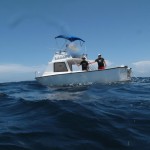
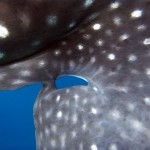

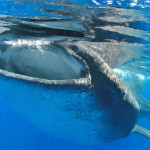
Neat-o!
Is the whale shark considered to be a “top of the pyramid” predator?
What is the total biomass of the world whale shark population? How much biomass does an adult whale shark ingest in a 24-hour period? Besides resting periods, are there times win a whale shark doesn’t eat?